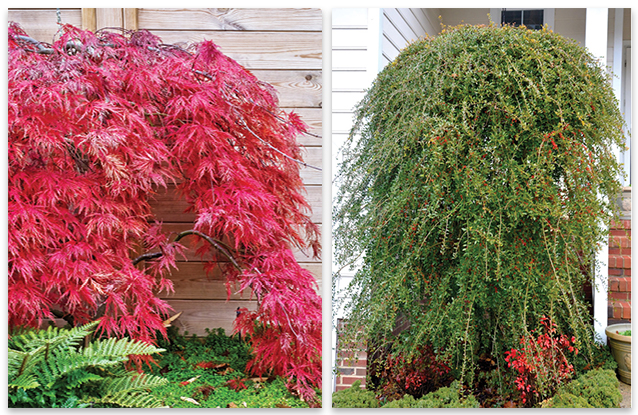Bring a graceful sense of movement to your landscape

Weeping redbud
“Weeping trees reach for the sky, then cascade to the earth,” says local landscape designer Linda Greenberg of the small tribe of plants whose branches grow in a gracefully drooping habit. “I love the contrast of the up and down motion.”
As the owner of Linda Greenberg Landscape & Design, she often uses the trees in Zen and memorial gardens. But their unusual form makes them focal point-worthy in any landscape, she says, “and narrow varieties can fill odd spaces, like between two windows.” Here, meet a selection that thrive in the Lowcountry.
Weeping Redbud (Cercis canadensis)
Size: Five to eight feet tall and wide, though some cultivars are larger
What’s to Love: When little else colors the early-spring garden, pink blooms fill bare branches. Many cultivars have green foliage, but Greenberg adores the purple-leaved ‘Ruby Falls’, which “provides beautiful contrast against a grey or white house.”
How to Grow: They can take full sun but prefer some shade during the summer, as well as moist, well-draining soil.

(Left to right) A weeping Japanese maple and a weeping yaupon holly
Weeping Japanese Maple (Acer palmatum)
Size: Four to six feet tall and wide, with larger cultivars available
What’s to Love: Their lacy leaves can be purple, green, or red and often change colors through the seasons. “Uplighting shows off all weeping trees but is especially stunning for Japanese maples,” notes Greenberg. Smaller cultivars fit well in borders (and do great in containers).
How to Grow: In a spot protected from high winds, with dappled sun and rich, slightly acidic, evenly moist, well-draining soil
Weeping Yaupon Holly (Ilex vomitoria)
Size: 15 to 30 feet tall and eight to 20 feet wide
What’s to Love: As an evergreen, this easy-grower is excellent for screening purposes. In the fall, female trees produce prolific red berries that attract wildlife; buy one with fruit on the branches if that feature is important to you.
How to Grow: In full sun to part shade; they tolerate dry or damp soils, as well as salt.